#Lancaster Canal
Explore tagged Tumblr posts
Text

The towpath of the Lancaster Canal in the height of summer, when shade is welcome.
8 notes
·
View notes
Text

Myerscough Hall Bridge
17 notes
·
View notes
Text



The Burrow Carvings, Lancaster City Museum, Lancaster
Group of carved stones, probably part of a third century mausoleum, temple or shrine.
This group, which is unique in this country, was found during the building of the canal south of Lancaster, near Burrow Heights, in 1794, The main Roman road into Lancaster passed close by.
The heads may represent the four winds or the four seasons and the standing figure (not shown) the deceased. The lions (one shown) are similar to a group of lions and stags from a shrine at Shorden Brae in Northumberland.
#Roman#roman mausoleum#tomb#roman road#roman city#roman britain#roman army#roman carving#roman sculpture#roman beliefs#ancient living#ancient crafts#ancient cultures#Lancaster
61 notes
·
View notes
Text



John Rennie the Elder was born on 7th June 1761
I think when we talk about our civil engineers Rennie sometimes gets overshadowed by the likes of Telford and the Stevensons, but Rennie’s work on canals, aqueducts, bridges and dockyards mark him as one of the greatest engineers of his age.
Rennie was the fourth son of a prosperous farmer on the Phantassie estate near the village of East Linton. He played truant from school to watch what went on at the local millwright’s workshop - run by the celebrated mechanic, Andrew Meikle, the inventor of the threshing machine - and began to work there when he was 12 years old, while continuing his education. He studied at Edinburgh University and then worked for the firm Boulton and Watt.
In 1791, Rennie moved to London and set up his own engineering business. His first works were canals, notably the Lancaster Canal, the Kennet & Avon Canal, and the Royal Military Canal, and also improving the drainage of the Norfolk fens.
Meanwhile Rennie also acquired experience as a bridge designer, using stone and cast iron to produce bridges with daringly wide arches. These included the Lune Aqueduct , Kelso Bridge , Waterloo Bridge, Southwark Bridge and London Bridge, which was completed to Rennie’s design by his son George after his death.
Rennie also worked on the development of docks and harbours for commercial purposes, including Grimsby, Leith and the London Docks . His largest projects were the civil engineering works required as the Royal Navy began to build the infrastructure, including Sheerness Dockyard and the great breakwater at Plymouth . Rennie was also commissioned to give advice on other novel maritime structures, notably steam-powered dredgers, diving bells and the famous Bell Rock lighthouse.
Rennie died, aged 60, after a short illness, at his house in Stamford Street, London, on 4th October 1821, and was buried in St. Paul’s Cathedral.
7 notes
·
View notes
Text


1st January 1945: Victoria Cross action of Flight Sergeant George Thompson. A wireless operator on Lancaster PD377 of 9 Squadron RAF, his aircraft had taken off from Bardney in Lincolnshire at 7:44am, part of a mission to bomb the Dortmund-Ems canal near Ladbergen. At the point of bomb release, the aircraft was hit by an 88mm anti-aircraft shell forward of the mid-upper turret. This disabled the intercom, damaged control cables and severed hydraulic pipes, starting a severe fire. A large hole was torn in the fuselage floor, the wind fanning the flames. 🔥
Another 88mm shell hit the nose of the aircraft almost simultaneously, shattering the Perspex canopy and setting the port inner engine alight. The pilot, Flying Officer Harry Denton, was briefly rendered unconscious but managed to regain control of his crippled aircraft with the help of his flight engineer. From his position, however, George Thompson could see that the mid-upper gunner, Sergeant Ernie Potts, was unconscious in his turret and surrounded by flames.
Thompson edged past the damaged fuselage floor and pulled Potts, whose clothing was on fire, from his turret; by this point, his own uniform was also alight. Despite this, Thompson carried Potts forward to safety and beat out the flames with his bare hands. Though already badly burned, he now went to the rescue of Haydn Price, the rear gunner, who had opened the doors of his turret only to receive severe burns to his head. He had then passed out due to shock and breathing in fumes from the fire.
By this point, much of Thompson’s clothing had been burned away and his face, hands and legs were badly blistered. Yet he somehow managed to get Price to safety, again using his hands to put out the flames on his comrade’s clothes. Due to the fierce wind rushing through the fuselage, he also sustained frostbite, which only added to the agony of his injuries. When he went forward to report the situation to his pilot, Denton was unable to recognise his own wireless operator.
Despite receiving further flak damage which damaged the starboard inner engine, the Lancaster crossed Allied lines into the Netherlands. Denton managed to crash land safely, with all the crew escaping from the wreckage. Ernie Potts died of his injuries just 18 hours later, while Haydn Price would eventually recover following multiple operations. It seemed at first that George Thompson might survive his terrible burns, but he contracted pneumonia and died on 23rd January.
On 20th February 1945, it was announced that Thompson had been awarded a posthumous Victoria Cross. His citation reads in part: “He hazarded his own life in order to save the lives of others. Young in years and experience, his actions were those of a veteran. One of the gunners… owes his life to the superb gallantry of Flight Sergeant Thompson, whose signal courage and self-sacrifice will ever be an inspiration to the Service.”
Pictured:
(R) Flight Sergeant George Thompson, VC.
📷©️IWM CH 14685
(L) Lancaster PD377, 9 Squadron RAF.
@JamieMctrusty via X
3 notes
·
View notes
Text

file: Lancaster Canal - geograph.org.uk - 4271321.jpg
2 notes
·
View notes
Text
Day Seventy

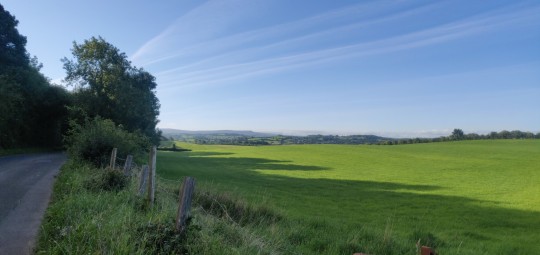

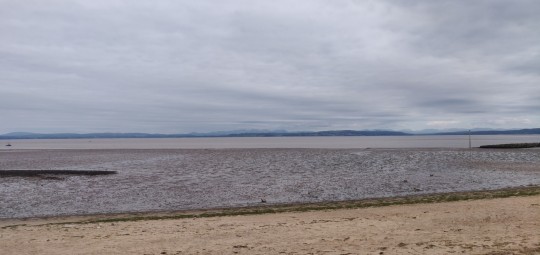
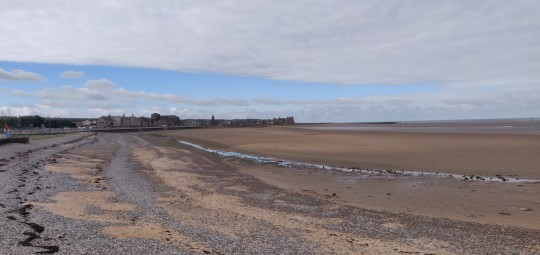
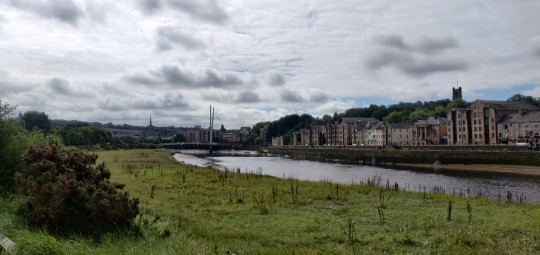
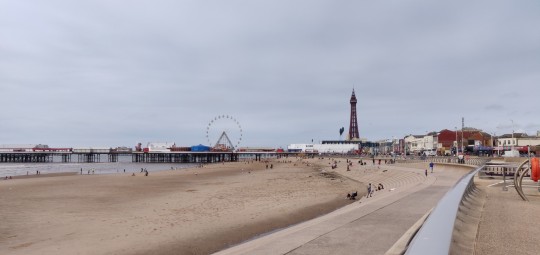
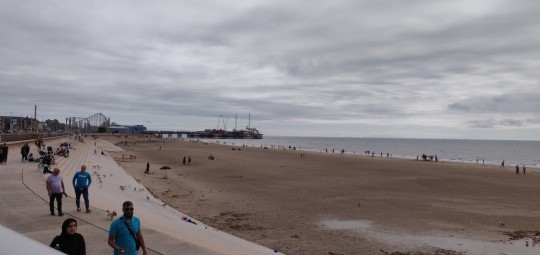
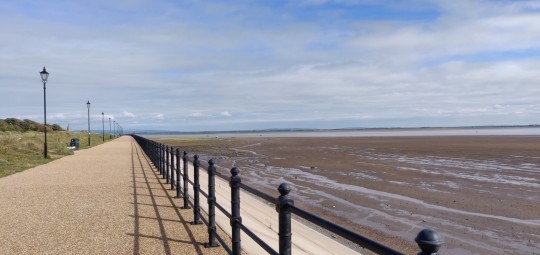
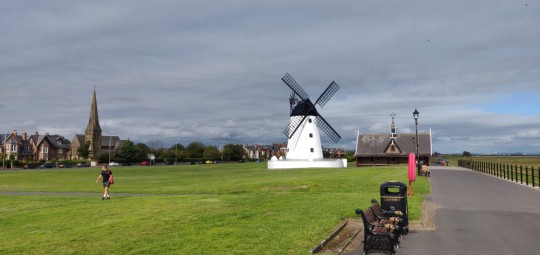
I realised I'd accidentally missed a count whilst dealing with the injury, which means today is in fact the ten week mark!
Up early from the woods by Silverdale, the sun is shining and the wind is low, should be a good day for the mileage!
Today's ride starts out with a nice glide downhill from Arnside & Silverdale AONB and across the wetlands of RSPB Leighton Moss, before rolling into Carnforth for a quick stop for supplies.
From here, it's time to jump on to the canal towpath heading alongside the A6 for some nice level riding. The towpath surface isn't great, alternating between stoney gravel or pockmarked with holes, but it's still enjoyable going through the tunnels of trees along the canalside.
The canal is followed down to Hest Bank, where I swing west to jump onto the coastline for a lovely ride along the seaside across to Morecambe.
The tide is out, and a ceiling of cloud has appeared, but it's high up and still a warm day, with the air clear enough to gaze right across the bay to see Helvellyn and its surrounding peaks in the Lake District standing proudly on the horizon.
After taking in the views awhile, it's time to head back inland along The Greenway cycle path, a great long stretch of smooth paving through some lovely forested sections down to the River Lune and historic Lancaster.
Crossing ove the river via the Millennium Bridge, the cycle route turns and tracks along the River Lune for another few miles all the way down to Condor Green. The path turns to a rocky bridleway halfway along which does slow progress and requires a deal of concentration to find viable routes to prevent the bike shaking me to bits, but what scenery I'm able to take in is still enjoyable.
I opt to take the bike route inland to cut out a section of A road, which ends up leading me into a few stiff climbs as it loops out and back again around the M6, before heading back out westward through Cockerham.
The route here is branded as the "Lancaster Cycleway", but in reality there is no provision whatsoever for cycling infrastructure, and it's a long slog along some busy roads with the wind starting to come in from the west, making for a bit of a tough section across the flats.
With there being no route across the River Wyre along the coast, the route swings south across the fields to reach the toll bridge at Great Ecclestone. Heading a little further south through Elswick, it's a further jaunt through windy country lanes westward along the B5269 as the hills begin to roll in a little.
The day is brightening though, and before long tue busy lanes turn into bugger, busier roads as we ride into the outskirts of Blackpool.
Doing what I can to avoid the seriously heavy traffic through much of town, I carry on westward a little further and hit the seaside again, with a nice sight if the famous Blackpool Tower.
The air is clear enough still to even catch a glimpse of the beautiful peaks of Snowdonia far across the water.
From the pleasure beach, it's time for a jaunt along the promenade. I've really enjoyed riding along a good few seaside promenades through this journey, and the stretch along from Blackpool is some of the best yet.
Some great smooth level riding right along the waterside, with a short jump onto the road before continuing again around the sandy expanses of St Anne's and the nature reserves by Lytham.
The view across the Ribble Estuary is gorgeous, with so much of the upcoming coast on display.
With some big urban stretches ahead, I don't want to progress too much further today and get caught up in them when trying to find a place to sleep, so I resolve to find a spot prior to Preston. But the legs are still feeling energetic currently, so I push on from Lytham and into rish hour.
The traffic on the road by Saltcotes is as heavy as it gets, but with an adjacent cycle path I have a good deal of pleasure pushing on and zooming past the queueing cars as the sun shines out once more, and carey on past Freckleton.
It's a stretch if dual carriageway here, but I'm feeling bullish and start charging down it. I realise I may have miscalculated as the miles grind down as before I know it I'm hitting the outskirts of Preston.
There are aome good cycle paths around here though, and I start following the Guild Wheel route along Savick Brook to scout out some possible stopping points to setup in.
Then I receive a lovely and unexpected present from the wonderful Ellie! Given that my back is still playing up somewhat after my fall, I decide to use it to book into a nice cheap B&B just a little further down the road to give me a nice soft bed to help aid the recovery a little more.
That's been a decent day's progress! Honestly wasn't expecting to get this far on today, but starting out tomorrow this deep into Preston puts me in a great position to get through the main urban challenges tomorrow, and possibly get over the border to Wales. We shall see what the morning holds.
TTFN!
6 notes
·
View notes
Link
0 notes
Text
Events 1.9 (after 1930)
1941 – World War II: First flight of the Avro Lancaster. 1945 – World War II: The Sixth United States Army begins the invasion of Lingayen Gulf. 1957 – British Prime Minister Sir Anthony Eden resigns from office following his failure to retake the Suez Canal from Egyptian sovereignty. 1959 – The Vega de Tera dam fails, triggering a disastrous flood that nearly destroys the town of Ribadelago and kills 144 residents. 1960 – President of Egypt Gamal Abdel Nasser opens construction on the Aswan Dam by detonating ten tons of dynamite to demolish twenty tons of granite on the east bank of the Nile. 1961 – British authorities announce they have uncovered the Soviet Portland spy ring in London. 1962 – Apollo program: NASA announces plans to build the C-5 rocket launch vehicle, then known as the "Advanced Saturn", to carry human beings to the Moon. 1964 – Martyrs' Day: Several Panamanian youths try to raise the Panamanian flag in the U.S.-controlled Panama Canal Zone, leading to fighting between U.S. military and Panamanian civilians. 1991 – Representatives from the United States and Iraq meet at the Geneva Peace Conference to try to find a peaceful resolution to the Iraqi invasion of Kuwait. 1992 – The Assembly of the Serb People in Bosnia and Herzegovina proclaims the creation of Republika Srpska, a new state within Yugoslavia. 1992 – The first discoveries of extrasolar planets are announced by astronomers Aleksander Wolszczan and Dale Frail. They discovered two planets orbiting the pulsar PSR 1257+12. 1996 – First Chechen War: Chechen separatists launch a raid against the helicopter airfield and later a civilian hospital in the city of Kizlyar in the neighboring Dagestan, which turns into a massive hostage crisis involving thousands of civilians. 1997 – Comair Flight 3272 crashes in Raisinville Township in Monroe County, Michigan, killing 29 people. 2003 – TANS Perú Flight 222 crashes on approach to Chachapoyas Airport in Chachapoyas, Peru, killing 46 people. 2004 – An inflatable boat carrying illegal Albanian emigrants stalls near the Karaburun Peninsula en route to Brindisi, Italy; exposure to the elements kills 28. This is the second deadliest marine disaster in Albanian history. 2005 – Mahmoud Abbas wins the election to succeed Yasser Arafat as President of the Palestinian National Authority, replacing interim president Rawhi Fattouh. 2005 – The Sudan People's Liberation Movement and the Government of Sudan sign the Comprehensive Peace Agreement to end the Second Sudanese Civil War. 2007 – Apple CEO Steve Jobs introduces the original iPhone at a Macworld keynote in San Francisco. 2011 – Iran Air Flight 277 crashes near Urmia in the northwest of the country, in icy conditions, killing 78 people. 2014 – An explosion at a Mitsubishi Materials chemical plant in Yokkaichi, Japan, kills at least five people and injures 17 others. 2015 – The perpetrators of the Charlie Hebdo shooting in Paris two days earlier are both killed after a hostage situation; a second hostage situation, related to the Charlie Hebdo shooting, occurs at a Jewish market in Vincennes. 2015 – A mass poisoning at a funeral in Mozambique involving beer that was contaminated with Burkholderia gladioli leaves 75 dead and over 230 people ill. 2021 – Sriwijaya Air Flight 182 crashes north of Jakarta, Indonesia, killing all 62 people on board.
0 notes
Text

One of the many bridges over the Lancaster Canal, and one of my friends waiting for me to stop fannying about, taking photos.
9 notes
·
View notes
Text
OCC Cardinal Standings - 2024-2025 Arena Football
Linden – McKinley – 8-3 Bishop Watterson – 7-4 Pickerington South – 6-5 Groveport Madison – 6-5 Canal Winchester – 6-5 Pickerington Central – 5-6 Reyoldsburg – 4-7 Delaware Perkins – 4-7 Lancaster Fisher Catholic – 3-8 KIPP Columbus – 3-8
0 notes
Text





October 4th saw the death of John Rennie, the famous engineer who constructed the Crinan Canal.
I think when we talk about our civil engineers Rennie sometimes gets overshadowed by the likes of Telford and the Stevensons, but Rennie’s work on canals, aqueducts, bridges and dockyards mark him as one of the greatest engineers of his age.
Rennie was born on 7th June 1761, the fourth son of a prosperous farmer on the Phantassie estate near the village of East Linton, 20 miles east of Edinburgh. He played truant from school to watch what went on at the local millwright’s workshop - run by the celebrated mechanic, Andrew Meikle, the inventor of the threshing machine - and began to work there when he was 12 years old, while continuing his education. He studied at Edinburgh University and then worked for Boulton and Watt, a firm based near Birmingham which manufactured steam engines.
In 1791, Rennie moved to London and set up his own engineering business. His first works were canals, notably the Lancaster Canal, the Kennet & Avon Canal, and the Royal Military Canal, and also improving the drainage of the Norfolk fens.
Meanwhile Rennie also acquired experience as a bridge designer, using stone and cast iron to produce bridges with daringly wide arches. These included the Lune Aqueduct , Kelso Bridge , Waterloo Bridge, Southwark Bridge and London Bridge, which was completed to Rennie’s design by his son George after his death.
Rennie also worked on the development of docks and harbours for commercial purposes, including Grimsby, Leith and the London Docks . His largest projects were the civil engineering works required as the Royal Navy began to build the infrastructure, including Sheerness Dockyard and the great breakwater at Plymouth . Rennie was also commissioned to give advice on other novel maritime structures, notably steam-powered dredgers, diving bells and the famous Bell Rock lighthouse.
Rennie died, aged 60, after a short illness, at his house in Stamford Street, London, on this day in 1821, and was buried in St. Paul’s Cathedral.
Pics are of Rennie, The Crinan Canal at Crinan Village and Ken Bridge near New Galloway.
4 notes
·
View notes
Text
Exploring Pennsylvania's Historic Legacy: A Journey Through Time
Pennsylvania, often called the Keystone State, is steeped in American history. Its rich heritage encompasses the birth of the nation, pivotal battles of the Civil War, and significant industrial advancements. A road trip through Pennsylvania's historic sites offers an immersive journey into the past, allowing travelers to connect with the stories that shaped the United States. This article will guide you through some of Pennsylvania's most remarkable historic sites and landmarks, providing a comprehensive itinerary for history enthusiasts and curious travelers alike.
Philadelphia: Cradle of Liberty
Philadelphia, Pennsylvania's largest city, is a cornerstone of American history. Begin your journey at Independence National Historical Park, home to some of the most iconic symbols of American freedom. Independence Hall, where the Declaration of Independence and the U.S. Constitution were signed, is a must-see. The adjacent Liberty Bell Center houses the Liberty Bell, a timeless emblem of liberty and justice.
Further exploring Philadelphia, visit the Betsy Ross House, where the first American flag was purportedly sewn. Wander down Elfreth's Alley, the oldest continuously inhabited residential street in the United States, to experience colonial-era architecture and charm. The National Constitution Center offers interactive exhibits and displays that delve into the history and significance of the U.S. Constitution, providing a comprehensive understanding of the nation's founding principles.
Valley Forge: Symbol of Endurance
A short drive from Philadelphia lies Valley Forge National Historical Park, a site that embodies the resilience and determination of the Continental Army during the harsh winter of 1777-1778. General George Washington and his troops endured severe conditions here, emerging as a more cohesive and disciplined force. The park features reconstructed huts, informative exhibits, and numerous trails that offer a deep dive into this critical period of the Revolutionary War.
Lancaster County: Amish Country and Industrial Heritage
Traveling west, Lancaster County presents a unique blend of history and culture. Known for its Amish community, the area offers a glimpse into a way of life that has remained largely unchanged for centuries. The Amish Farm and House provides tours that explain Amish traditions, lifestyle, and history.
In Strasburg, the Railroad Museum of Pennsylvania showcases the state's pivotal role in the development of the railroad industry. The museum's extensive collection of historic locomotives and railroad artifacts highlights how railroads transformed transportation and commerce in America.
Gettysburg: Turning Point of the Civil War
No historical tour of Pennsylvania would be complete without visiting Gettysburg National Military Park. The Battle of Gettysburg was a turning point in the Civil War, and the site is now preserved as a national park. The visitor center offers extensive exhibits, a museum, and the Gettysburg Cyclorama, a massive painting depicting the battle. Key locations such as Little Round Top, Pickett's Charge, and Devil's Den provide a vivid sense of the battlefield's scale and significance. Guided tours, whether by bus or licensed battlefield guide, offer detailed insights into the strategies and outcomes of this historic clash.
Central Pennsylvania: Engineering Feats and Cultural Heritage
The Allegheny Portage Railroad National Historic Site commemorates an early engineering marvel in central Pennsylvania near Altoona. Before railroads capable of crossing steep gradients were built, the portage railroad used a series of inclined planes to transport canal boats over the Allegheny Mountains. Visitors can explore the remains of the railroad, a reconstructed engine house, and exhibits that detail this innovative solution to a challenging transportation problem.
Further west, Johnstown is known for the Johnstown Flood National Memorial, which marks the site of the devastating 1889 flood that claimed over 2,200 lives. The memorial offers a sobering look at the disaster, its causes, and its aftermath, including efforts to improve dam safety and flood control.
Fallingwater: Architectural Wonder
Continuing southwest, Fallingwater is a testament to Frank Lloyd Wright's genius. This architectural masterpiece, built for the Kaufmann family in 1935, is celebrated for its harmonious integration with the natural landscape. The house appears to float over a waterfall, embodying Wright's philosophy of organic architecture. Tours of Fallingwater provide an intimate look at Wright's innovative design and the home's unique construction.
Harrisburg: Capital City Splendor
Pennsylvania's state capital, Harrisburg, boasts the stunning Pennsylvania State Capitol building. Completed in 1906, this Beaux-Arts masterpiece is adorned with murals, sculptures, and stained glass. Guided tours offer insights into the building's history, architecture, and the workings of the state government. Nearby, the State Museum of Pennsylvania features exhibits on the state's history, industry, and natural resources.
Hershey: Sweet History
Every trip to Pennsylvania is complete with a visit to Hershey, which is synonymous with chocolate. This town, founded by Milton S. Hershey, offers a blend of history and modern attractions. Hershey's Chocolate World provides an interactive tour of the chocolate-making process, while the Hershey Story Museum delves into Milton Hershey's life and the company's history. For some fun, Hersheypark, an amusement park, adds a sweet twist to your historical road trip.
Pittsburgh: Industrial Powerhouse
Finally, head to Pittsburgh, a city that played a crucial role in America's industrial growth. The Heinz History Center, an affiliate of the Smithsonian Institution, offers exhibits on the city's industrial heritage, including the steel industry, sports history, and the legacy of H.J. Heinz. The Carnegie Museum of Natural History and the Carnegie Museum of Art provide further cultural and historical insights.
Pennsylvania's rich historical landscape offers a captivating journey through time. From the revolutionary fervor of Philadelphia to the Civil War battlegrounds of Gettysburg and the industrial innovations of Pittsburgh, the state's historic sites and landmarks tell the story of America's evolution. Whether a history buff or a curious traveler, a road trip through Pennsylvania promises a deep and enriching exploration of the past. So, set out on this journey through the Keystone State and uncover the stories that have shaped the nation.
0 notes
Text
Pariah heap - savagely subjecting myself to humiliation
Outward slovenly appearance bespeaks volumes wordsworth their weight in gold (exhumed from the pith of these lovely bones - beclothed with mottled skin) presages afterlife of hellish horror (think Dante's inferno), nevertheless a respite from earthly torture wracking mein kampf since conception. I lived without great expectations diploid on an impossible mission set in motion courtesy triggered pleasure zones, when natural propensity toward mortality yielded mutual intense or paroxysmal excitement after unbridled love making between then young parents of mine approximately circa early/mid April nineteen hundred and fifty eight. Begot upon initial cleavage of two gametes genetic fate decreed upon yours truly, when nine months later a scrawny boy traversed thru the birth canal uneventfully into the hands of waiting obstetrician. Mother placed me near her bosom, where I busted thru ample cleavage nursed courtesy milk of human kindness until she became high and dry pacified scraggly baby, who screamed at the top of his little lungs possibly linked to submucous palate split uvula - diagnosed years later by specialist at Lancaster Cleft palate clinic. Severe nasality as Aladdin in grade school linkedin with extreme introvertedness grist for the role as scapegoat bully me pronounced major inferiority complex prevailed. Suicidal ideation throve as unhealthy psychological bumper crop: I cared not a whit for mine body, mind, and soul negligent hygienic habits - unkempt appearance abhorred cleanliness, greaseball outlier videlicet witnessed infrequent visits to bathing or showering facilities let hair grow long and ratty, and shaggy passive aggressive stance toward family of origin members sought refuge in mine bedroom remained metaphorically hermetically sealed until emerging adulthood entrenched, fixated, and glued to aforementioned behavioral traits. Challenged, piqued, and tested and tried patience of parents passed their threshold of tolerance. Overstayed welcome at 324 Level Road at the receiving end of hollow ultimatums browbeaten courtesy damning epithets fueled glowering hatred, issuing kickass brickbats, out the mouths of mommy dearest or papa, silently internalized their vicious wrath. Smoldering rage within me tamped down as brilliant comeuppance
did not visit mother on her deathbed,
nevertheless wept profusely
while wailing "I love you" over the telephone, and every May fourth -
since two thousand and five
crafted commemorative poems,
she always asked
for written acknowledgement
at the least remembering her birthday -
November thirteenth -
from second born and singular son.
No escape from
being called oppressive scatological names, neither at home nor at school, and including riding the bus
brutal, short and nasty invectives
assaulted my sensitive eardrums
of course with futility
impossible mission to deflect
blacked banal barbs,
whether besieging me
from so called wonderful,
albeit infuriated parents
continually wounding mine ego, which pride of self never robust
subsequently such regular
(unleaded) cruelty outsourced to every ogre witnessed an aggrieved boy
silently pained courtesy
whiplash of words accosting consciousness
submissively accepting battering
haranguing, poisoning, stinging standing stockstill forbearance vetting psyche, the tragedy exhibited
by stoic facade and charade
generating absolute zero responsiveness from an introverted
anxiety plagued youngster, who grew up emotionally,
physically and spiritually stunted
scratching out pathetic poetry.
0 notes
Link
0 notes
Text
Events 7.4 (before 1840)
362 BC – Battle of Mantinea: The Thebans, led by Epaminondas, defeated the Spartans. 414 – Emperor Theodosius II, age 13, yields power to his older sister Aelia Pulcheria, who reigned as regent and proclaimed herself empress (Augusta) of the Eastern Roman Empire. 836 – Pactum Sicardi, a peace treaty between the Principality of Benevento and the Duchy of Naples, is signed. 993 – Ulrich of Augsburg is canonized as a saint. 1054 – A supernova, called SN 1054, is seen by Chinese Song dynasty, Arab, and possibly Amerindian observers near the star Zeta Tauri. For several months it remains bright enough to be seen during the day. Its remnants form the Crab Nebula. 1120 – Jordan II of Capua is anointed as prince after his infant nephew's death. 1187 – The Crusades: Battle of Hattin: Saladin defeats Guy of Lusignan, King of Jerusalem. 1253 – Battle of West-Capelle: John I of Avesnes defeats Guy of Dampierre. 1333 – Genkō War: Forces loyal to Emperor Go-Daigo seize Tōshō-ji during the Siege of Kamakura. Hōjō Takatoki and other members of the Hōjō clan commit suicide, ending the rule of the Kamakura shogunate. 1359 – Francesco II Ordelaffi of Forlì surrenders to the Papal commander Gil de Albornoz. 1456 – Ottoman–Hungarian wars: The Siege of Nándorfehérvár (Belgrade) begins. 1534 – Christian III is elected King of Denmark and Norway in the town of Rye. 1584 – Philip Amadas and Arthur Barlowe arrive at Roanoke Island. 1610 – The Battle of Klushino is fought between forces of the Polish–Lithuanian Commonwealth and Russia during the Polish–Muscovite War. 1634 – The city of Trois-Rivières is founded in New France (now Quebec, Canada). 1744 – The Treaty of Lancaster, in which the Iroquois cede lands between the Allegheny Mountains and the Ohio River to the British colonies, was signed in Lancaster, Pennsylvania. 1774 – Orangetown Resolutions are adopted in the Province of New York, one of many protests against the British Parliament's Coercive Acts. 1776 – American Revolution: The United States Declaration of Independence is adopted by the Second Continental Congress. 1778 – American Revolutionary War: U.S. forces under George Clark capture Kaskaskia during the Illinois campaign. 1802 – The United States Military Academy opens at West Point, New York. 1803 – The Louisiana Purchase is announced to the American people. 1817 – In Rome, New York, construction on the Erie Canal begins. 1818 – US Flag Act of 1818 goes into effect creating a 13 stripe flag with a star for each state. New stars would be added on July 4 after a new state had been admitted. 1827 – Slavery is abolished in the State of New York. 1831 – Samuel Francis Smith writes "My Country, 'Tis of Thee" for the Boston, Massachusetts July 4 festivities. 1832 – John Neal delivers the first public lecture in the US to advocate the rights of women. 1832 – Durham University established by Act of Parliament; the first recognized university to be founded in England since Cambridge over 600 years earlier. 1837 – Grand Junction Railway, the world's first long-distance railway, opens between Birmingham and Liverpool. 1838 – The Iowa Territory is organized.
0 notes